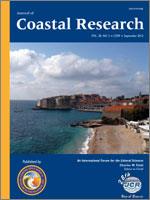Browne, N.K.; Smithers, S.G.; Perry, C.T., and Ridd, P.V., 2012. A field-based technique for measuring sediment flux on coral reefs: application to turbid reefs on the Great Barrier Reef.
Inshore turbid reefs on the Great Barrier Reef (GBR) are exposed to high and fluctuating sediment loads normally associated with poor reef growth, but many have high coral cover (>30%) and diversity (>50 species). Previous assessments of sediment regimes on these reefs have largely relied on sediment trap data, which overestimate sedimentation rates and may not accurately reflect sedimentary conditions. A new approach, based on paired sediment trays, is described here that allows the sedimentation rate, sediment resuspension, and total mass of mobile sediments transported on to and off of a site per unit time and area (termed the two-way total sediment flux) to be measured or calculated. The sediment trays were deployed on Middle Reef and Paluma Shoals, two inshore turbid reefs on the GBR where the two-way total sediment flux ranged from 34 g/m2/d in protected reef habitats to more than 640 g/m2/d in higher-energy settings. Mean sedimentation rates, calculated using data from four sites across these reefs, of less than 122 g/m2/d are considerably lower than published rates estimated for nearby coral reefs, largely because sediment traps limit sediment resuspension. At each tray installation, sediments were collected every 4 to 6 weeks to measure variations in net sedimentation through the year, and resuspension rates were calculated by comparing 100 g of preanalysed sediments placed on trays at deployment to sediments recovered 2 weeks later. These data demonstrate that despite high sediment delivery rates, net sedimentation may still be relatively low and potentially less of a threat to benthic communities on turbid reefs than previously assumed. Sediment trays provide a comprehensive assessment of sediment regimes that, together with ecological assessments of coral cover, improve our understanding of the sedimentary pressures affecting inshore turbid reefs and their ability to tolerate sedimentation.





